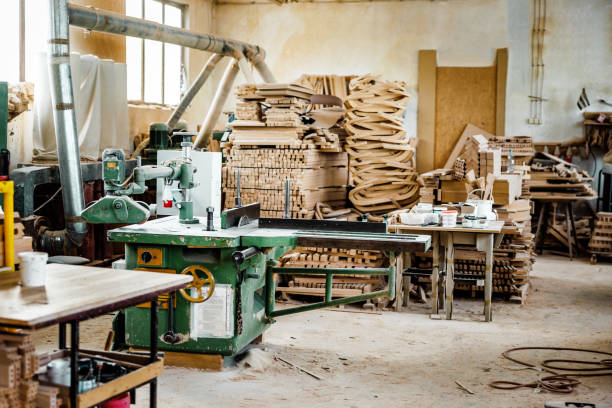Introduction – Poland’s Wood Working Machinery Tools Market in Statistical Focus
Poland’s woodworking machinery and tools market is carving out a notable space in the global export landscape. As of 2024, the country held a 0.82% share in global exports of woodworking blades, exporting around 829,000 kilograms. That may sound modest at first, but a 4.4% year-on-year growth and a 3.14% CAGR over five years signal steady momentum.
Zooming out to the broader European woodworking machine-tools market, projections show growth at a 1.7% CAGR, reaching $5.1 billion by 2035. Poland’s contribution is backed by powerful manufacturing infrastructure, a skilled labor force, and a strong export ecosystem.
With primary markets like Mexico, Ukraine, and Russia accounting for 92% of its tool exports, Poland has positioned itself as a vital link in the international woodworking supply chain. Add to that the recent opening of Wood-Mizer’s 11,000 m² facility in Koło and the buzz generated at trade fairs like All4Wood and DREMA, and it’s clear: Poland is serious about woodworking innovation.
This makes now the perfect time for buyers to adopt a data-driven approach when selecting suppliers—and platforms like Freshdi are making that easier than ever by offering real-time RFQ trends, supplier verification, and aggregated market insights.
Deep Dive – Key Production, Export Statistics & Current Demand Data
Let’s break down the numbers. While granular data for woodworking machinery production is limited, insights from Poland’s electrical and electronic equipment sector (which includes woodworking tools) are telling. In 2024, exports from this segment reached USD 43.98 billion—12.4% of all Polish exports. Germany led the pack as the top buyer with USD 13.58 billion, followed by the UK and the US.
Now, why does this matter for woodworking tools? Because these products are often bundled within broader industrial equipment categories. So, surging demand in electrical exports likely reflects rising interest in automated woodworking machinery.
RFQ activity on Freshdi supports this, showing increased buyer demand from regions like North America, Southeast Asia, and the Middle East. What’s more, buyers are looking beyond just price—they’re asking for certifications, production timelines, and sustainability practices.
Top 9 Verified Wood Working Machinery Tools Suppliers in Poland – Leading Exporters by Volume
These suppliers have been vetted based on export volume, industry reputation, international certifications, and positive reviews from Freshdi’s user community.
-
Inchem Polonia Export Eastern Markets
A consistent performer in Eastern European markets, Inchem Polonia is known for high-grade tools and tailored export solutions. Their strength lies in adapting machinery to regional needs. -
Kawa Service Polska Sp. Z O.O.
Specializing in maintenance tools, automation systems, and integrated machinery, Kawa Service is a go-to for mid-to-large-scale suppliers seeking turnkey solutions. -
Wood-Mizer Industries
A global leader with deep roots in Poland, Wood-Mizer recently opened a massive facility in Koło to streamline production and logistics. Their sawmills and portable machines are globally recognized. -
Fabryka Obrabiarek do Drewna (FOD)
One of the oldest players in the game, FOD is known for its robust, industrial-grade machines like sawmills and edgers. Their legacy of quality stretches back to 1865. -
REMA S.A.
With over a century of experience, REMA specializes in circular sawing machines and equipment tailored for furniture production. They’re a staple supplier for EU-based manufacturers. -
Seron Sp. z o.o.
Seron designs and produces CNC machines for woodworking. Their customized machinery is in high demand across Germany, Scandinavia, and Central Europe. -
Goma Sp. z o.o.
A family-owned business that has evolved into a modern manufacturer, Goma is known for complete woodworking lines and after-sales support. -
ITM Polska
Best known for its industrial exhibitions, ITM also partners with machinery producers and exports advanced solutions for wood and metal. -
Walter Kompressortechnik Polska
Though primarily known for compressors, Walter supplies integrated solutions for dust extraction and pressurized systems widely used in woodworking plants.
Dynamic Ranking Note: Rankings may vary monthly based on supplier activity and export volume. Platforms like Freshdi regularly update performance metrics, showcasing “Suppliers of the Month/Quarter” to help buyers make informed decisions.
Market Navigation – Statistical Trends, Value Dynamics & Export Dynamics
Let’s talk about trends. In 2024, Poland’s furniture sector—a major consumer of woodworking machines—faced a 6% drop in exports and a 4-5% dip in production value. Despite that, Poland held its spot as Europe’s 3rd and the world’s 6th largest furniture exporter.
So, what’s happening beneath the surface?
Export Dynamics
Export growth to emerging markets like the Czech Republic (+144%), China (+109%), and the US (+60%) suggests a shift in strategy—Polish exporters are diversifying. This plays directly into the hands of machinery suppliers, who now need to cater to different regulatory standards and performance expectations.
Seasonal Price Shifts
The average export price of woodworking tools jumped to $7,210 per ton in 2024, a 14% hike from the previous year. This wasn’t random—currency fluctuations, raw material costs, and logistics all played a part. Smart buyers use this data to time their purchases, and Freshdi’s trend dashboards are a handy tool for that.
Forecasts and Market Outlook
Experts are cautiously optimistic about 2025. While global competition remains fierce—especially from China, Vietnam, and Turkey—Poland is betting big on automation and digitalization.
At the DREMA 2025 fair, AI-enhanced machinery and robotics stole the spotlight. These innovations are expected to contribute significantly to cost efficiency and product quality, essential levers for competing on a global scale.
Conclusion – Leveraging Data for Strategic Sourcing
Poland’s woodworking machinery and tools industry is more than just numbers—it’s a story of resilience, innovation, and global ambition. With a stable export base, a strong manufacturing tradition, and a growing focus on tech-driven solutions, Polish suppliers are well-positioned for 2025 and beyond.
For buyers, this means one thing: strategic sourcing is no longer optional. You need to choose suppliers based not just on price, but on reliability, production capacity, export performance, and adaptability.
That’s where platforms like Freshdi come in. By offering supplier verification, RFQ tracking, and market analytics, Freshdi empowers you to make confident sourcing decisions—whether you’re a small importer or a multinational distributor.
Key Takeaways
- Poland holds a growing slice of the global export pie for woodworking machinery and tools.
- Top markets include Mexico, Ukraine, and Russia—with new markets rapidly emerging.
- Rising prices and fluctuating demand make timing and data crucial.
- Verified suppliers like Inchem Polonia and Kawa Service Polska lead the pack in October 2025.
- Innovations in automation and AI are reshaping the machinery landscape.
Buyer’s Checklist for Sourcing Wood Working Machinery Tools from Poland
✅ Check supplier export performance and certifications
✅ Use Freshdi to track RFQ trends and market prices
✅ Review seasonal price data before placing large orders
✅ Consider suppliers with innovations in automation and sustainability
✅ Monitor emerging markets for expansion opportunities
Future Outlook
The road ahead looks promising. As Poland leverages its manufacturing prowess and tech investments, its woodworking machinery suppliers are set to become even more competitive globally. Expect more automation, smarter machines, and highly responsive suppliers geared toward international demand.
And with Freshdi continuously updating supplier rankings and market intel, you’ve got the tools to stay one step ahead.
FAQs
1. Why is Poland a key player in woodworking machinery tools exports?
Poland combines a strong manufacturing base, skilled workforce, and competitive pricing. Its central location in Europe also makes it a logistical hub for exports.
2. How can I verify the credibility of Polish suppliers?
Use platforms like Freshdi that offer supplier verification, trade history, and buyer reviews to ensure transparency.
3. Are prices for woodworking tools expected to rise in 2025?
Prices saw a 14% increase in 2024. While some stabilization is expected in 2025, factors like raw material costs and demand spikes could influence pricing.
4. What are the most in-demand woodworking tools from Poland?
Circular saws, CNC machines, and automated edge banders are top requests, especially from furniture manufacturers and carpentry workshops.
5. How often do supplier rankings change on Freshdi?
Freshdi updates rankings monthly or quarterly based on supplier activity, RFQ volume, and buyer feedback. Look for “Supplier of the Month” features for up-to-date insights.
References
- reportlinker.com
- indexbox.io
- volza.com
- woodandpanel.com
- twmmagazine.com
- en.wikipedia.org – FOD
- en.wikipedia.org – REMA
- trade.gov.pl – Furniture Exports
- furnituretoday.com
- tradingeconomics.com
- Freshdi


